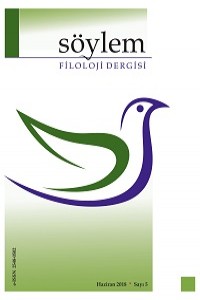Abstract
Tanzimat
döneminin ve Türk romantizminin öncü isimlerinden olan; edebi eserlerinden çok
edebiyat kuramına dönük olarak ortaya koyduğu eserleriyle bilinen ve bu nedenle
çağdaşları tarafından “üstad” kabul edilen Recaizade Mahmut Ekrem, 15 yaşında kaybettiği
oğlu Nijad Ekrem'i sıklıkla şiirlerine ve mensur şiirlerine konu edinmiştir. Bu
eserlerde Nijad, okurun karşısına olağanüstü bir figür olarak çıkar: Bir
filozof gibi derin düşüncelere yönelir; en ince zevkleri bulunan sanatçılarla
hemen hemen aynı estetik duyarlılığı taşır; milli ve dini hassasiyetleri son
derece gelişmiştir; olgun insanlara yakışır şekilde saygı ve nezaket sahibidir
vs. İşte bu çalışmada, söz konusu özellikler ekseninde, Nijad'ın olağanüstü bir
figür olarak tipleştirilmesinin üzerinde durulacak ve daha çok eser-merkezli
bir okuma perspektifinden hareketle Ekrem'in Tefekkür ve Nijad Ekrem
adlı eserlerinde beliren tipolojik yönelim üzerine bir yorumsamaya
gidilecektir.
Keywords
References
- Kavaz, İbrahim (2002). Belgelerle Âkif Paşa: Hayatı ve Eserleri, Elazığ: Üniversite Kitabevi.
- Kris, Ernest-Kurz Otto (2016). Sanatçı İmgesinin Oluşumu: Efsane, Mit ve Büyü. Sabri Gürses (Çev.), İstanbul: İthaki Yayınları.
- Parlatır, İsmail (2012). Recaî-zade Mahmut Ekrem. Ankara: Akçağ Yayınları.
- Recaizade Mahmut Ekrem (2014a). Bütün Eserleri 1: Nijad Ekrem-Tefekkür. Hakan Sazyek vd. (Haz.), Kocaeli: Umuttepe Yayınları.
- Recaizade Mahmut Ekrem (2014b). Bütün Eserleri 2: Takdîr-i Elhân-Kudemadan Birkaç Şair-Pejmürde-Takrizat. Hakan Sazyek vd (Haz.), Kocaeli: Umuttepe Yayınları.
- Shiner, Larry (2013). Sanatın İcadı: Bir Kültür Tarihi. İsmail Türkmen (Çev.), İstanbul: Ayrıntı Yayınları.
- Tanpınar, Ahmet Hamdi (2007). XIX. Asır Türk Edebiyatı Tarihi. Abdullah Uçman (Haz.), İstanbul: Yapı Kredi Yayınları.
- Tevfik Fikret (2010). Rübâb-ı Şikeste ve Diğer Eserleri. Fahri Uzun (Haz.), İstanbul: İnkılâp Kitabevi.
- Todorov, Tzvetan (2012). Fantastik: Edebi Türe Yapısal Bir Yaklaşım. Nedret Öztokat (Çev.), İstanbul: Metis Yayınları.
Abstract
Recaizade
Mahmut Ekrem, who is one of the leading names of Tanzimat period and Turkish
romantism, is known for his opinions about literary theories rather than
literary works and hence, he is recognized by his contemporaries as “master”.
He often brought his son Nijad Ekrem, whom he lost at the age of 15, into his
poems and prose-poems. In these works, Nijad appears as an extraordinary figüre
in the face of the reader: He, like a philosopher, goes to deep thoughts; has
almost the same aesthetic sensitivity as artists who have the finest pleasures;
his national and religious sensitivities improved greatly, and he has respect
and grace of mature people.
This
work will focus on the characterization of Nijad as an extraordinary figure in
the context of mentioned features, and an interpretation will be made on the
typological orientation in Ekrem's works Tefekkür
and Nijad Ekrem by means of a
more work-centered reading perspective.
Keywords
References
- Kavaz, İbrahim (2002). Belgelerle Âkif Paşa: Hayatı ve Eserleri, Elazığ: Üniversite Kitabevi.
- Kris, Ernest-Kurz Otto (2016). Sanatçı İmgesinin Oluşumu: Efsane, Mit ve Büyü. Sabri Gürses (Çev.), İstanbul: İthaki Yayınları.
- Parlatır, İsmail (2012). Recaî-zade Mahmut Ekrem. Ankara: Akçağ Yayınları.
- Recaizade Mahmut Ekrem (2014a). Bütün Eserleri 1: Nijad Ekrem-Tefekkür. Hakan Sazyek vd. (Haz.), Kocaeli: Umuttepe Yayınları.
- Recaizade Mahmut Ekrem (2014b). Bütün Eserleri 2: Takdîr-i Elhân-Kudemadan Birkaç Şair-Pejmürde-Takrizat. Hakan Sazyek vd (Haz.), Kocaeli: Umuttepe Yayınları.
- Shiner, Larry (2013). Sanatın İcadı: Bir Kültür Tarihi. İsmail Türkmen (Çev.), İstanbul: Ayrıntı Yayınları.
- Tanpınar, Ahmet Hamdi (2007). XIX. Asır Türk Edebiyatı Tarihi. Abdullah Uçman (Haz.), İstanbul: Yapı Kredi Yayınları.
- Tevfik Fikret (2010). Rübâb-ı Şikeste ve Diğer Eserleri. Fahri Uzun (Haz.), İstanbul: İnkılâp Kitabevi.
- Todorov, Tzvetan (2012). Fantastik: Edebi Türe Yapısal Bir Yaklaşım. Nedret Öztokat (Çev.), İstanbul: Metis Yayınları.
Details
| Primary Language | Turkish |
|---|---|
| Subjects | Creative Arts and Writing |
| Journal Section | ARAŞTIRMA MAKALELERİ (TÜRKÇE ) |
| Authors | |
| Publication Date | June 22, 2018 |
| Submission Date | January 24, 2018 |
| Acceptance Date | March 3, 2018 |
| Published in Issue | Year 2018 Volume: 3 Issue: 1 |

This work is licensed under a Creative Commons Attribution-NonCommercial-NoDerivatives 4.0 International License.


